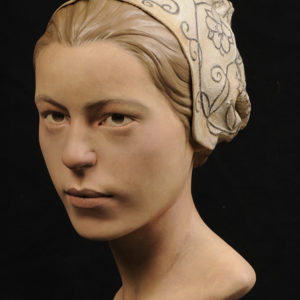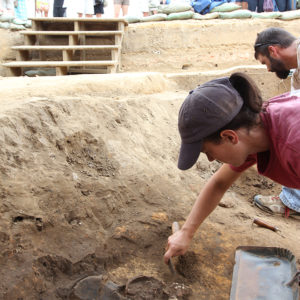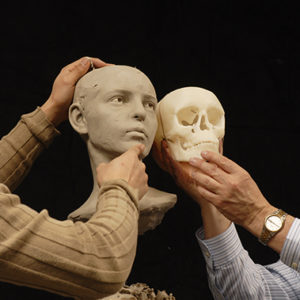 The Smithsonian Institution, the Colonial Williamsburg Foundation, and Preservation Virginia have confirmed the first scientifically-proven occurrence of survival cannibalism in Colonial America. The collaboration was prompted by the archaeological discovery of a partial human skull and tibia during last summer’s excavation of a trash deposit in the L-shaped cellar in the middle of James Fort. The deposit dates to the winter of 1609-1610—often referred to as the “starving time” at Jamestown—when sickness, starvation, and Indian attacks led to the deaths of more than 200 men, women, and children crowded into James Fort. While several written accounts exist about survival cannibalism in the American colonies, this is the first time such cannibalism has been proven by forensic evidence. “Our team has discovered partial human remains before, but the location of the discovery, visible damage to the skull and marks on the bones immediately made us realize this finding was unusual,” said Dr. Bill Kelso, director of archaeological research at the Jamestown Rediscovery Project. “We approached the Smithsonian’s National Museum of Natural History for further research because of their proven understanding of the contextual history in this part of Virginia.” Dr. Douglas Owsley, head of the physical anthropology division at the museum, identified chops to the forehead and back of the cranium to open the head; knife cuts on the jaw and cheek indicating removal of the flesh; and markings indicating the head’s left side was punctured and pried apart—all physical evidence consistent with survival cannibalism. Further investigation of the remains allowed Dr. Owsley to determine the subject’s sex, age, ancestry, and status. The shape of the skull and size of the tibia indicate the remains are female. Examination of molar development and the growth stage of the joint below the knee indicate that she was about 14 years old. Isotopic testing found she had consumed a European diet of wheat and meat, while oxygen levels and skull shape reiterated her country of origin. The research team has named her “Jane.” Her identity is unknown, and although DNA samples have been saved for future examination, there is little hope of identifying modern relatives for comparative testing. Based on the anthropological evidence of her diet and the archaeological layer where her partial remains were found, researchers believe Jane arrived in Jamestown in August 1609, just months before the worst of the “starving time.” “The ‘starving time’ was brought about by a trifecta of disasters: disease, a serious shortage of provisions, and a full scale siege by the Powhatans that cut off Jamestown from outside relief,” said Jim Horn, Colonial Williamsburg’s vice president of research and historical interpretation and an expert on Jamestown history. “Survival cannibalism was a last resort—a desperate means of prolonging life at a time when the settlement teetered on the brink of extinction.” A new exhibit telling Jane’s story opened Friday May 3 at The Nathalie P. and Alan M. Voorhees Archaearium at Historic Jamestowne.
The Smithsonian Institution, the Colonial Williamsburg Foundation, and Preservation Virginia have confirmed the first scientifically-proven occurrence of survival cannibalism in Colonial America. The collaboration was prompted by the archaeological discovery of a partial human skull and tibia during last summer’s excavation of a trash deposit in the L-shaped cellar in the middle of James Fort. The deposit dates to the winter of 1609-1610—often referred to as the “starving time” at Jamestown—when sickness, starvation, and Indian attacks led to the deaths of more than 200 men, women, and children crowded into James Fort. While several written accounts exist about survival cannibalism in the American colonies, this is the first time such cannibalism has been proven by forensic evidence. “Our team has discovered partial human remains before, but the location of the discovery, visible damage to the skull and marks on the bones immediately made us realize this finding was unusual,” said Dr. Bill Kelso, director of archaeological research at the Jamestown Rediscovery Project. “We approached the Smithsonian’s National Museum of Natural History for further research because of their proven understanding of the contextual history in this part of Virginia.” Dr. Douglas Owsley, head of the physical anthropology division at the museum, identified chops to the forehead and back of the cranium to open the head; knife cuts on the jaw and cheek indicating removal of the flesh; and markings indicating the head’s left side was punctured and pried apart—all physical evidence consistent with survival cannibalism. Further investigation of the remains allowed Dr. Owsley to determine the subject’s sex, age, ancestry, and status. The shape of the skull and size of the tibia indicate the remains are female. Examination of molar development and the growth stage of the joint below the knee indicate that she was about 14 years old. Isotopic testing found she had consumed a European diet of wheat and meat, while oxygen levels and skull shape reiterated her country of origin. The research team has named her “Jane.” Her identity is unknown, and although DNA samples have been saved for future examination, there is little hope of identifying modern relatives for comparative testing. Based on the anthropological evidence of her diet and the archaeological layer where her partial remains were found, researchers believe Jane arrived in Jamestown in August 1609, just months before the worst of the “starving time.” “The ‘starving time’ was brought about by a trifecta of disasters: disease, a serious shortage of provisions, and a full scale siege by the Powhatans that cut off Jamestown from outside relief,” said Jim Horn, Colonial Williamsburg’s vice president of research and historical interpretation and an expert on Jamestown history. “Survival cannibalism was a last resort—a desperate means of prolonging life at a time when the settlement teetered on the brink of extinction.” A new exhibit telling Jane’s story opened Friday May 3 at The Nathalie P. and Alan M. Voorhees Archaearium at Historic Jamestowne.
related images
- Facial reconstruction of the bones of a teenage English girl whose bones show evidence of cannibalization
- Jamestown Rediscovery Archaeologist Mary Anna Richardson excavates around Jane’s remains
- Researchers compare facial reconstruction with skull model








